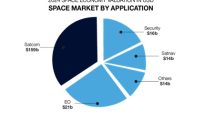 By Saurabh Gupta, Chief Technology Officer of Beyon.
By Saurabh Gupta, Chief Technology Officer of Beyon.
The primary use case for satellite-enabled 5G in the region is to provide high-speed connectivity and widespread coverage for internet and mobile services; for example, in difficult to reach and rural areas, and to enable remote industries such as Mining and Agriculture, as well as for disaster response and emergencies, that could render regular terrestrial infrastructure unusable. By seamlessly integrating with terrestrial networks, satellites offer tremendous potential for delivering seamless wireless 5G experiences across the region.
Comprehensive Coverage for Rapid Demand
The GCC is one of the fastest-growing regions in the world for 5G adoption. 5G subscribers in the GCC are expected to reach 75% by 2027, according to Nokia’s most recent Middle East and Africa Mobile Broadband Index and 86% by 2028, according to Ericsson’s latest Mobility Report. Usually Low Earth Orbit (LEO) satellites are a popular choice for enabling 5G as they facilitate a relatively lower latency, and faster transmission of data than satellites at higher altitudes. Although regional development of integrating satellite technology for 5G is in the early stages, LEOs covering adjacent geographies can combine constellations that ensure seamless, wide-scale coverage over a specific geographic area, allowing for increased 5G coverage and faster deployment than land-based networks alone, which in turn could enable operators to meet the growing demands of 5G in the region.
Satellites are well-positioned to supplement wide 5G coverage for terrestrial cable infrastructure in unserved or underserved areas in the region such as deserts and rural locations housing industrial, military or aerospace activities. A patchy coverage in hard-to-reach geographies would defeat the purpose and make the service unattractive; therefore, it is key to ensure adequate coverage across the relevant target geographical areas. Saudi Arabia witnessed the first steps in the development of space-based 5G mobile communications services combining cellular and satellite non-terrestrial networks earlier this year.
Satellites face fewer hindrances from physical assets making them suitable for extending higher capacity and faster 5G coverage. This can accommodate areas with overcrowded data traffic or which are logistically challenging to access as these locations would normally offer disproportionately low financial returns for fibre optic cables or terrestrial 5G networks. Therefore, satellite-enabled 5G can be cost-effective for aiding the Middle East’s biggest industry vertical – Oil & Gas – handling enterprise traffic and real-time surveillance over expansive geographies. A successful demonstration of the first satellite-enabled 5G backhaul in the Middle East utilising Medium Earth Orbit (MEO) satellites was held at the beginning of the year proving its viability.
Reliable and Efficient Communications
Satellite-enabled 5G offers a durable backup for terrestrial networks and uninterrupted communication in unfortunate situations such as natural disasters. Offshore maritime and energy sites, rural healthcare centres, agricultural farms and manufacturing plants in the GCC require high throughput and low latency network connectivity that could be provided by satellite-enabled 5G, ensuring reliable and resilient communications for emergency and business-critical applications in case of any unavailability of terrestrial networks. Further reduction in latency and increase in throughput will enhance the effectiveness and appeal of satellite usage. Satellite technology could also enable efficient bandwidth utilisation for 5G and a seamless transition between satellite and land-based networks will ensure ubiquitous connectivity.
Moreover, newer software-defined satellites that allow satellites to be reprogrammed while in orbit can boost telecommunications operator flexibility. Satellite-enabled 5G can then provide more reliable broadband capacity customisation to different geographic areas and at different times, allowing for optimized resource usage. Earlier in the year, the UAE received its first 5G network capabilities over a software-defined satellite, giving users access to enhanced speed, coverage and scalability to cater to future high bandwidth demands.
Novel User Experiences
The proliferation of mobile devices in recent years has shifted consumer preferences towards low-latency on-demand streaming. 5G-enabled satellites can help make immersive mobile experiences, such as high-definition streaming and virtual reality, the norm by enabling higher broadband capacity transmission and cost-effective backhaul for mobile networks across expansive geographical areas. This can facilitate the rapid rise of relatively novel services like cloud gaming and drone delivery that have immense potential in the GCC.
Enabling Security in the Internet of Things (IoT)
The growing number of IoT devices constitutes an enormous operational challenge for data transmission in the region. Additionally, satellite infrastructure will need to maintain high security posture to ensure the end-to-end communication networks remain highly secure and fully compliant with all user expectations and regulatory obligations on baseline security and data privacy. With constant updates needed to maintain device security, satellite-enabled 5G can provide a more efficient data distribution through expansive coverage and broadcast capacity with shared connectivity. This means satellite-enabled 5G can support managed connectivity for moving cars, vessels, airplanes and other IoT devices, enabling applications for integrated navigation and fleet management. As a result, the Mohammed Bin Rashid Space Centre (MBRSC) in the UAE recently launched the PHI-Demo satellite, which includes an advanced IoT communication payload enabling data collection and transmission from IoT devices utilizing state-of-the-art 5G technology.

Although satellite technology integration with 5G is still nascent in the GCC, 5G supplies a networking framework, allowing satellites to build on terrestrial networks and deliver enhanced connectivity through improved coverage, reliable and resilient communications, novel use cases and advanced IoT devices integration in the region. An extremely critical factor to consider is that satellite providers will require spectrum allocation to use relevant frequencies for data transmission. This is to avoid interference with existing networks, and as a result, they will need appropriate regulatory approvals and close coordination.” In conclusion, satellites will play an increasingly critical role in the coming years in complementing the GCC’s existing land-based networks and advancing the potential of regional connectivity.












Add Comment